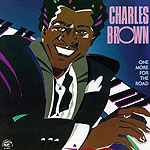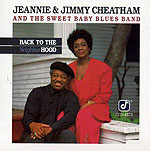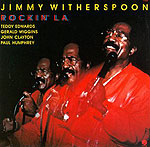
Exploring the jazz side of the blues
|
These reviews first appeared in the September/October 1989 issue of Living Blues magazine.
These three releases represent differing shadings of the jazz side of blues, and should do a lot to give jazz-oriented blues a wider audience.
Much of the material to be heard on these discs is of a contemplative, introspective variety, owing much to Jimmy Rushing, Billie Holiday, and the other early jazz/blues vocalists. Subsequent influences, such as the "cool" period of jazz and Frank Sinatra's phrasing style, are also evident.
Although these artists are drawn from the fabric of jazz, and the makeup of their bands is dotted with reeds and horns (with Billy Butler on Brown's album the only guitarist present), their music is indisputably blues. Or, as Jeannie Cheatham is fond of saying, "Musicians never split the blues from the jazz." (Bop altoman Charles McPherson put it more succinctly when he said, "Jazz begins and ends with the blues.")
Without arguing the point of differentiating blues from jazz, these albums are excellent efforts by the respective artists and should please all fans of blues.
Charles Brown was a regular R&B chart-topper in the 1950s, with hits such as "Driftin' Blues," "Black Night" and "Merry Christmas Baby" before fading into the club scene as the '60s unfolded. Two years ago (in 1986), "One More for the Road" was recorded and issued by Blue Side Records. When Blue Side folded, the album went out of print. Enter Alligator Records, famed for its stable of "houserockin'" blues and blues-rock. While Brown's sophisticated brand of blues is far different from anything Alligator has released before, Alligator founder/president Bruce Iglauer was suitably impressed by what he heard and consequently reissued the album.
Brown's tasteful piano work and deep, sonorous vocals, combined with the richness of his compositions, makes for one of the best albums Alligator has issued.
The first song, "I Cried Last Night," is indicative of the album as a whole. Brown's throaty vocals are offset by Harold Ousley's tenor sax passages, while Ousley's beautiful solos are bracketed by Brown's short statements on piano.
Ousley then introduces "Save Your Love For Me" with a warm, timeless passage, reminiscent of a Gershwin theme with a blues twist. Brown's own influence on Ray Charles' vocal style, as well as that of rock singer Randy Newman, is in full evidence on this slow, meandering piece. Butler gets his first guitar solo here, with a rhythmic, jazz style akin to the Barney Kessel school.
The standards "One For My Baby (and One More for the Road)" and "Route 66" are the musical treats of the album. In Brown's hands, no song is just a song, but instead becomes a story and a slice of life, with his piano playing expressing as much as the lyrics. And while "One for My Baby" will forever be associated with Sinatra, Brown still makes the song uniquely his own, with his unique phrasing and highly individualistic voice.
"Route 66" is treated in a jazz style, but the quality of the performance is so high that even the most hardcore of blues fans would be hard put to register a complaint. "Cottage for Sale" is a tear-jerking blues, with a tale of broken-hearted misery set against Brown's down-home piano. Ousley's slow, breathy sax passages are equally melancholy. The mood is more upbeat on "My Heart is Mended," but Brown returns to the blues for "I Miss You So" and "Travelin' Blues."
Like Ray Charles, whom he heavily influenced when Charles' career was first beginning in the early '50s, Brown's music spans popular R&B, traditional blues and jazz without ever compromising authenticity.
Jeannie and Jimmy Cheathams' album, like Brown's, is a spicy amalgam of blues and jazz pieces. The regular cast of the Sweet Baby Blues Band returns (augmented by newcomer Clora Bryant on trumpet), and, continuing the tradition of featuring a guest artist on each album, violinist Papa John Creach performs on three numbers.
While Creach's performances are warm and memorable, and star trumpeter Snooky Young (of the "Tonight Show" and Basie bands) gets plenty of room to stretch out, the pull of the band still comes back to Jeannie Cheatham.
With a voice that ranges from quiet and reassuring to full-throttled and irate tigress, Jeannie's singing is as at home on the boogie woogie of "Big Bubba's Back Rub Boogie Blues" and the slow blues of "Rock Me In Your Arms Tonight" as it is on the torch standard "Evenin'."
Jeannie also shows another side of her piano playing. While previous albums have contained only one non-blues tune – "Detour Ahead" from "Homeward Bound" – "Back to the Neighborhood" contains both "Evenin'" and "Call Me Darling." She is as adept at switching styles on piano as when singing.
The band, too, shines on the two slower pieces. Young's solo on "Evenin'" is a wonderful tidbit of traditional jazz, with Snooky growling and snarling, singing and dancing – all through his horn. And on "Call Me Darling," Papa John lays down sensitive lines on violin behind Jeannie's sad story before Jimmie Noone Jr. proffers some sage advice on clarinet.
The majority of the album, though, is concentrated firmly in the blues. A slow, haunting rendition is given by Jeannie of Lil Green's classic "In the Dark." Bryant adds her two cents' worth, taking her trumpet into the upper register without ever losing the richness of her tone.
Baritone saxist Dinky Morris gets his chance in the spotlight on Leonard Feather's composition "Salty Papa," following Papa John's solo with a thick, funky passage of his own.
The rhythm section may be led by Jeannie at piano, but drummer John "Ironman" Harris and bassist Red Callender keep a subtle swing going throughout. While neither gets an solo space, it hardly matters for their influence is so pervasive that a spotlight is unnecessary.
The album closes out like the Cheathams' previous three with a rousing blues anchored by the Sweet Baby Blues Glee Club. "Take the Wrinkles Out Your Birthday Suit" is every bit the bawdy, uptempo craziness that the now-famous "Meet Me With Your Black Drawers On" was on their first album.
Throughout "Back to the Neighborhood," Jimmy Cheatham's arrangements are as tight as a Count Basie riff, allowing the mid-sized combo to achieve a big band-level of richness on the horn choruses. Jimmy also gives the soloists lots of opportunity to show off, and provides each with a suitable frame constructed of the horn chorus that complements and punctuates the solos without ever intruding.
With Jimmy and Jeannie Cheathams' still-fresh compositional skills contributing five new songs to the album, this is their most balanced and satisfying album to date.
Witherspoon is about the same age as Charles Brown; both are in their late 60s. But while Brown as toiled the past 30 years in relative obscurity, Witherspoon has never strayed too far from the spotlight his vocal talent has afforded him.
So rather than the comeback vehicle Brown's album serves as, "Rockin' L.A." is instead a portrait of a mature artist in full control. This fine album was recorded in October of last year during a performance at the Los Angeles Biltmore.
"You Got Me Runnin'" starts the album off smoothly, with Witherspoon's hoarse, raspy and yet warmly melodic vocals leading the band through the slow boogie (with an aside of Jimmy Reed's "Bright Lights, Big City" tossed in). Teddy Edwards' sax solo is full of big-hearted blues, and Gerald Wiggins' piano is as reassuring in its own right as Cheatham's or Brown's.
"Once There Lived a Fool" is the first of two self-penned compositions on the album. A slow, jazzy piece with a blues feel, this song exhibits Witherspoon at his best: no histrionics, hooting or shouting – just a warm, finely controlled sense of passion. Edwards answers Witherspoon's lyrics with long, meandering walks, while drummer Paul Humphrey uses brushes to build tension up to a break, pacing the song perfectly.
Witherspoon's second composition, "Sweet Lotus Blossom," is another jazz signature piece a la Billy Eckstine. Edwards' solo here is full of blues figures, and also shows a rhythmic interplay between R&B and easy swing. Wiggins, too, demands to be heard on his solo, with powerful passages that hold up well to the standard set by Witherspoon's vocals. Even bassist John Clayton takes a passage for a solo, with several imaginative runs.
T-Bone Walker's "Call it Stormy Monday" gets one of its all-time great renditions here. Jimmy Rushing is then brought to mind on "Gee Baby, Ain't I Good to You" that the earlier singer made famous with Basie's outfit back before World War II. And Wiggins' piano introduction further reminds of Basie, before Witherspoon takes over.
The nod to Kansas City continues with "Don't You Miss Your Baby," part of a medley. The rest of the medley consists of "Careless Love, a hot rendition of "When the Saints Go Marching In" (including a bowed solo by Clayton on bass), and Rudy Toombs' "One Scotch, One Bourbon, One Beer."
The album closes out strongly with "SKI Blues," "I Want a Little Girl" and the classic "Big Boss Man."
Taken as a group, this trio would serve any blues fan as an excellent introduction to the often ignored jazz side of the blues. Singly, each album also represents some of the best work of each artist.


 Rockin' L.A.
Rockin' L.A.